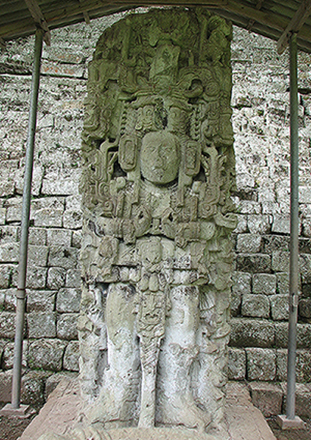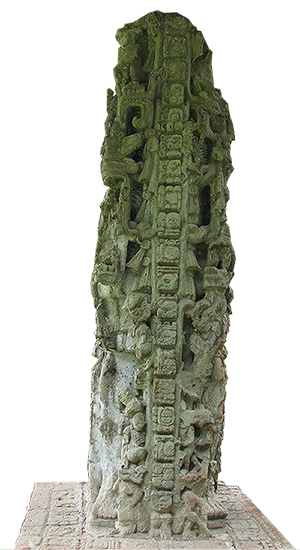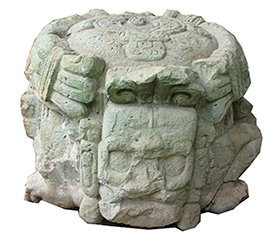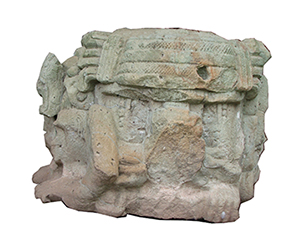Stela N
Location: Base of Hieroglyphic Stairway Courtyard, Base of Temple 11
Dates:
- 9.15.6.16.5 6 Chicchan 3 Yaxk'in (R14 Accession)
- 9.15.17.13.10 11 Oc 13 Pop (R15 Accession)
- 9.16.10.0.0 1 Ajaw 3 Zip (Dedication)
Kings: 15, 14, 16?
Measurements: 11.68 feet x 4.03 feet x 3.08 feet, relief 1.31 feet deep (North) and 1.48 feet (South)


Stela N North and South
Stela N South - Adalberto H V. Copán Stela N (Edited), 2009, photograph. Wikimedia Commons.
Stela N North Courtesy of Dr. Clark Erickson
Stela N is fifteenth ruler K’ahk’ Yipyaj Chan K’awiil’s second stela after Stela M. He continues his style of high relief with depth at almost one and a half feet and figural detail wrapping around the sides. This stela is classified as a Type V with two figural sides and 2 textual sides, though the text on the east and west sides comprise of only one column (Fash 2004, 259; Baudez 1994, 83). Underneath the stela is cached five bowls, ten flower pots, and stalactites, noticeably less extravagant than even Stela M’s offerings, which contained a spondylus shell and jadeite (Baudez 1994, 83, 74). The stela is paired with a zoomorphic altar.
Both the north side and south side depict a young king seemingly emerging from the mouth of the Witz creature and by connection the Underworld. Both figures wear a waterlily headdress being eaten by a fish surrounded by braid and tassel as well as a beaded cape, pectoral mask, serpent bar, and square earrings (Baudez 1994, 83). K’awiil heads emerge out of the serpent bar on both sides. Both men also have ancestor figures above their heads and a witz entity by their feet, sinking back into the Underworld (Baudez 1994, 84). However, whereas the north face wears an assumedly serpentine helmet, the south figure’s helmet is crocodilian (Baudez 1994, 85). On both sides, the kings are surrounded by fertility spirits adorned with waterlily blossoms and Witz elements (Baudez 1994, 86).


From Left to Right, Stela N East and West
Photos (Edited) Courtesy of Dr. Clark Erickson
The text mentions both K’ahk’ Joplaj Chan K’awiil and K’ahk’ Yipyaj Chan K’awiil’s accession dates, yet also seems to mention Yax Pasaj Chan Yopaat by name as “New Sky at Horizon” or “Rising Sun” (Schele and Grube 1988, 289; Baudez 1994, 87). This title is also believed to be the name of the stela <Baudez 1994, 87). It has been suggested that the figures represented on this stela are K’ahk’ Yipyaj Chan K’awiil and Yax Pasaj Chan Yopaat for this reason. In this case, the invocation of K’ahk’ Joplaj Chan K’awiil would serve to anchor the lineage and further add authority to the fifteenth king declaring his successor. Of note, the stela is placed at the base of Temple 11, previously known as the “lineage house of Yax K’uk’ Mo’, potentially providing a further anchor (Fash 1991, 168).
This action would explain why both kings appear young and why they both appear to emerge from the Underworld rather than one going into the Underworld (Baudez 1994, 87). It would also explain why the figures appear on the north and south sides of the stela rather than the more traditional west and east for death and rebirth respectively. The fertility imagery in the abundance of water lily motifs and bacabs may further provide authority to the lineage as being responsible for the continuation of this cycle.
The Altar


Altar Sides West - Death Mask crowned with Plant Life and North - Jaguar Head
Photos (Edited) Courtesy of Dr. Clark Erickson
The associated altar continues this theme of death and its role in perpetuating fertility. Though the west and east sides are broken, four heads comprise the sides of the altar. The east side contains a bat mask while the west side contains a death mask crowned with plant life. The north and south sides contain jaguar faces, each with a corresponding leg. Three circles, possibly representing the Witz sign, can be found on the east and south sides. A trilobed shell with ajaw glyphs form the top of the altar. The bat and jaguar masks, particularly when coupled with Witz symbols, can represent death and the Underworld. When coupled with fertility stemming from death in the west mask, this altar emphasizes this cycle (Baudez 1994, 87, 90).
Motifs
- Ancestor Figures
- Bacabs
- Bat
- Bicephalic zoomorph
- Braid and Tassel
- Crocodile
- Crossed Bands
- Double Figure Stela
- Intertwined Serpents
- Jaguar
- K'awiil
- Red Paint
- Serpent
- Serpent Bar
- Shell
- Torch in Forehead
- Turban
- Water Lily
- Witz
See Also:
- Stela C
- Stela 3
- Stela 5
- Stela M
Sources:
- Baudez, Claude-François. 1994. Maya Sculpture of Copán: The Iconography. Norman: University of Oklahoma Press.
- Fash, Barbara W. 2004. “Early Classic Sculptural Development at Copan.” In Understanding Early Copan, edited by Ellen E. Bell, Marcello A. Canuto, & Robert J. Sharer, 249-264. Philadelphia: University of Pennsylvania Museum of Archaeology and Antrhopology
- Martin, Simon and Nikolai Grube. 2008. Chronicle of the Maya Kings and Queens: Dynasties of the Ancient Maya. London: Thames and Hudson
- Schele, Linda. 1986. “Copan Note 8: The Founders of Lineages at Copan and Other Maya Sites” In Copan Notes, The, 1-21. Austin, TX: Copan Mosaic Project.
- Schele, Linda and Nikolai Grube. 1988. “Copan Note 39: The Father of Smoke Shell” In Copan Notes, The, 289-290. Austin, TX: Copan Mosaic Project.
- Stone, Andrea and Marc Zender. 2011. Reading Maya Art: A Hieroglyphic Guide to Ancient Maya Painting and Sculpture. London: Thames and Hudson.
Photographs:
- Copán Stela N (Edited) by Adalberto Hernandez Vega, is licensed under CC-by-2.0
- Other Photographs (Edited) Courtesy of Dr. Clark Erickson